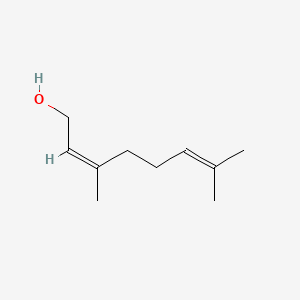| Authors | Title | Published | Journal | PubMed Link |
|---|---|---|---|---|
| Chen M et al. | Use of synthetic isoprenoids to target protein prenylation and Rho GTPases in breast cancer invasion. | 2014 | PLoS ONE | pmid:24587105 |
| Liu J et al. | Genome-wide analysis of terpene synthases in soybean: functional characterization of GmTPS3. | 2014 | Gene | pmid:24768723 |
| Rekha KR and Selvakumar GP | Gene expression regulation of Bcl2, Bax and cytochrome-C by geraniol on chronic MPTP/probenecid induced C57BL/6 mice model of Parkinson's disease. | 2014 | Chem. Biol. Interact. | pmid:24768735 |
| Ritala A et al. | Evaluation of tobacco (Nicotiana tabacum L. cv. Petit Havana SR1) hairy roots for the production of geraniol, the first committed step in terpenoid indole alkaloid pathway. | 2014 | J. Biotechnol. | pmid:24530945 |
| Schwaighofer A et al. | Honey bee odorant-binding protein 14: effects on thermal stability upon odorant binding revealed by FT-IR spectroscopy and CD measurements. | 2014 | Eur. Biophys. J. | pmid:24362824 |
| Hagvall L et al. | Finding the optimal patch test material and test concentration to detect contact allergy to geraniol. | 2013 | Contact Derm. | pmid:23510343 |
| Marcuzzi A et al. | Mouse model of mevalonate kinase deficiency: comparison of cytokine and chemokine profile with that of human patients. | 2013 | Pediatr. Res. | pmid:23760140 |
| Camelo-Méndez GA et al. | Comparative study of anthocyanin and volatile compounds content of four varieties of Mexican roselle (Hibiscus sabdariffa L.) by multivariable analysis. | 2013 | Plant Foods Hum Nutr | pmid:23715788 |
| Rekha KR et al. | Geraniol ameliorates the motor behavior and neurotrophic factors inadequacy in MPTP-induced mice model of Parkinson's disease. | 2013 | J. Mol. Neurosci. | pmid:23943375 |
| Lübbert M et al. | Transient receptor potential channels encode volatile chemicals sensed by rat trigeminal ganglion neurons. | 2013 | PLoS ONE | pmid:24205061 |
Nerol
Nerol is a lipid of Prenol Lipids (PR) class. The involved functions are known as Odorant, Anabolism, Diastasis, Metabolic Inhibition and Oxidation. Nerol often locates in germ tube. The related lipids are Octanols, Pinene, Hexanols, ethyl butyrate and ethyl hexanoate.
Cross Reference
Introduction
To understand associated biological information of Nerol, we collected biological information of abnormalities, associated pathways, cellular/molecular locations, biological functions, related genes/proteins, lipids and common seen animal/experimental models with organized paragraphs from literatures.
What diseases are associated with Nerol?
There are no associated biomedical information in the current reference collection.
No disease MeSH terms mapped to the current reference collection.
PubChem Associated disorders and diseases
What pathways are associated with Nerol
There are no associated biomedical information in the current reference collection.
PubChem Biomolecular Interactions and Pathways
Link to PubChem Biomolecular Interactions and PathwaysWhat cellular locations are associated with Nerol?
Visualization in cellular structure
Associated locations are in red color. Not associated locations are in black.
Related references are published most in these journals:
| Location | Cross reference | Weighted score | Related literatures |
|---|
What functions are associated with Nerol?
Related references are published most in these journals:
| Function | Cross reference | Weighted score | Related literatures |
|---|
What lipids are associated with Nerol?
Related references are published most in these journals:
| Lipid concept | Cross reference | Weighted score | Related literatures |
|---|
What genes are associated with Nerol?
There are no associated biomedical information in the current reference collection.
What common seen animal models are associated with Nerol?
There are no associated biomedical information in the current reference collection.
